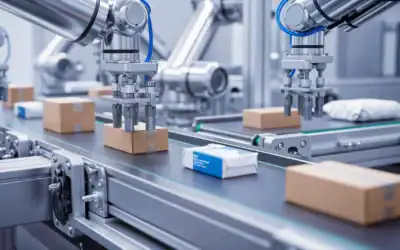The Ultimate Guide to AR, VR, and MR:
Differences, Popularity, and Challenges
Our world is changing, shaped by the advancements in emerging technologies. From artificial intelligence to robotics, experts acknowledge that technology is developing rapidly, shifting the way it interacts with all aspects of human life. This includes the increase in the use of AR, VR, and MR in several sectors, especially manufacturing.
The efficiencies AR, VR, and MR technologies can bring to manufacturing and the way they can transform operational efficiencies can be immense with their ability to bring a competitive advantage to a business. They are valuable tools that increase efficiency, enhance training, and drive innovation.
But what’s the difference between AR, VR, and MR? How immersive is each one? What about accessibility and hardware? Let’s explore each of these technologies in detail.
AR – Augmented Reality
AR, or augmented reality, is a technology that enhances the real world with computer-generated information. It can be used in several ways, such as marker-based, which allows for the AR software to identify objects and overlay them with virtual content. AR can also be markerless by using recognition algorithms, and it can be as simple as using a projection to overlay an environment.
AR Immersion
In terms of immersion, while AR does present a significant contribution to an immersive experience, it is not heralded as the most immersive in comparison to VR and MR. A user of AR will have to maintain awareness of their surroundings, and while this does assist with safety, it does shift how immersive AR truly is, and presents a challenge if the objective is full immersion.
AR Hardware
A compelling opportunity around AR is the low entry point of hardware requirements. AR software can be used on standard tablets and smartphones, or it can be taken further by combining a smartphone with a headset. AR glasses can also be used for an even more immersive experience.
AR in Manufacturing
While AR can be used in more than just manufacturing, this technology has a strategic advantage in the manufacturing industry. With its ability to enhance the real world, AR can enhance operational efficiency and also train new or existing employees without having to stop or slow down routines on the floor.
AR in Daily Life
Outside of manufacturing, AR is used commonly in gaming, but AR is also popular in product development, marketing, architecture, and interior design, as it allows a designer or developer to properly realise their vision before spending a significant amount of capital on an actual 3D model. Another opportunity for AR applications is in education settings, where AR technology can enhance learning.
AR Accessibility
While some emerging technologies have the ability to be accessible to those who require accommodations, the accessibility of AR lands entirely with the developer of AR software. Features such as text enlargement, colour contrasts, and audio recognition can be added to make AR more accessible, but it is not a requirement, and it can make accessing AR a challenge for certain people. Typically, though, AR is regarded as more popular than VR as it is more accessible between the two options.
VR – Virtual Reality
VR, or virtual reality, is a similar technology that also utilises computer-generated content, but VR simulates an entirely new environment, completely blocking out the real world, and allowing the user to completely immerse themselves. Of course, this presents opportunities and risks of its own.
VR Immersion
Depending on the kind of hardware and software used, VR can be highly immersive as the user’s entire world is replaced with something new. Furthermore, the way a user interacts with a VR world is through a controller, which isn’t something often used for AR applications. This displays interesting opportunities to truly engage people with a highly immersive experience.
VR Hardware
In comparison to AR, VR has a significantly higher barrier to entry. While some VR headsets only involve the insertion of a smartphone, these are often regarded as having lower-quality graphics and lower processing power compared to headsets dedicated to VR immersion, but they also require more investment. This is another reason why AR is seen as a more popular choice.
VR in Manufacturing
A key opportunity for VR is in manufacturing. It can be adopted to help train new employees to show them the exact processes they will be responsible for in the larger scheme of operations, but VR can also be used to contribute to the testing of prototypes and reviewing the safety risks that may be associated with new machinery.
VR in Daily Life
Much like AR, VR has significant applications in gaming, but it also has applications on social media platforms, allowing for friends and family to meet up in a virtual reality setting, and it can also be used in healthcare to enhance a patient’s experience in therapy or counselling.
VR Accessibility
However, VR presents challenges regarding accessibility. While a draw of VR technology is the freedom of movement that will be given while utilising it, this does not assist users with motor disabilities or visual impairments, and often the controllers for VR lack tactile functions or haptic feedback which can make a more inclusive experience.
MR – Mixed Reality
Meeting in the middle between AR and VR is MR: mixed reality. This technology projects holograms into the real world, much like AR, but they interact with real-life objects, like VR. MR allows the user to interact with both real and virtual objects and the holograms can often respond to commands.
MR Immersion
In comparison to AR and VR, MR is widely considered more immersive than AR, but not as immersive as VR. With the blend of both technologies, as well as the combination of the real world and virtual one, and virtual interactivity, MR presents an immersive experience that’s deeply engaging.
MR Hardware
As MR is a blend of VR and AR, the headsets of VR, as well as glasses and smartphones for AR, can all often be used for an MR experience, allowing for a low barrier to entry to use this technology.
MR in Manufacturing
With MR’s ability to synthesise both AR and VR, this can be a compelling opportunity for the manufacturing industry. MR in manufacturing can allow for 3D prototyping of new products and head-mounted displays can feed workers real-time information, which overall increases operational efficiency.
MR in Daily Life
There are significant opportunities for MR applications in daily life, such as helpful digital overlays that assist people with directions or advice about current traffic conditions, as well as the ability to see how a piece of furniture will look in a home before purchase.
MR Accessibility
This interactive blend of virtual and reality is regarded as more accessible than both VR and AR, but that doesn’t mean there are no challenges. Those with visual, auditory, motor, or cognitive impairments may not be able to easily access the technology without specific support integrations from a developer.
AR, VR, and MR: The Shared Challenges
Despite their differences, there are shared challenges in AR, VR, and MR. AR is a relatively new innovation, and as strategic as it can be to adopt to improve processes and workflow in manufacturing, there can be a significant learning curve to it. As for VR, while it has been around much longer than AR and MR, the equipment has only recently stopped being so bulky in recent years as innovation has improved.
The response to utilising AR, VR, and MR is also low due to the content scarcity, as well as the often high costs of the hardware to use the technology, and there are also ethical concerns to take into consideration. Encountering any harmful content while utilising AR, VR, or MR can deal significant damage to mental wellbeing.
The Future Trends of AR, VR, and MR
Despite the reluctance to adopt AR and VR, both in manufacturing and other industry applications, the two technologies, as well as MR, are becoming increasingly more mainstream, particularly with the addition of AI into these software applications. The potential impact of artificial intelligence, combined with the ever-evolving and more wearable AR, VR, and MR hardware, these technologies are slowly becoming more ingrained into everyday life and are here to stay.
Intretech and Emerging Technologies
At Intretech, we drive manufacturing forward, navigating the complexities of your operations to make them more efficient – including the use of AR, VR, and MR. Examining every aspect from design and innovation to supply chain management in a variety of industries, Intretech supplies smart manufacturing solutions for global brands.
To find out more about Intretech
Explore more related content
Critical Minerals, Critical Thinking: Building Resilient Electronics Supply Chains
Critical Minerals, Critical Thinking: Building Resilient Electronics Supply ChainsThe global economy is expected to...
Cybersecurity for Smart Factories: A 2025 Playbook for OT Resilience
Cybersecurity for Smart Factories: A 2025 Playbook for OT ResilienceWhy "smart" now means "secure" or not at all Smart...
Digital Product Passports for Small Appliances & Air Purifiers
Digital Product Passports for Small Appliances & Air Purifiers: A 2025–2027 Manufacturer Playbook From the Oxera...



